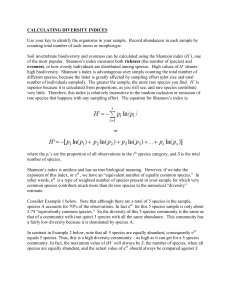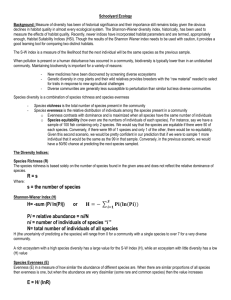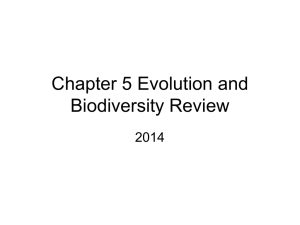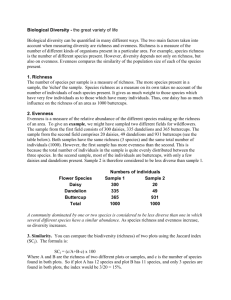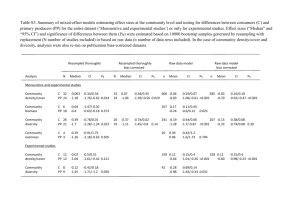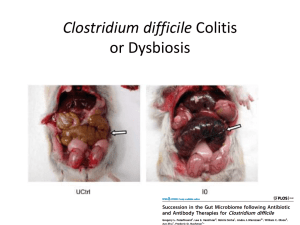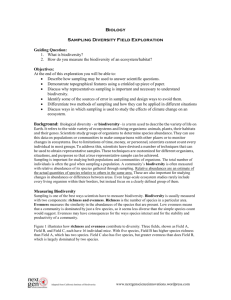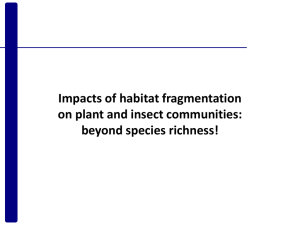N2= 1/Ʃpi² - Environmental Statistics Group
advertisement
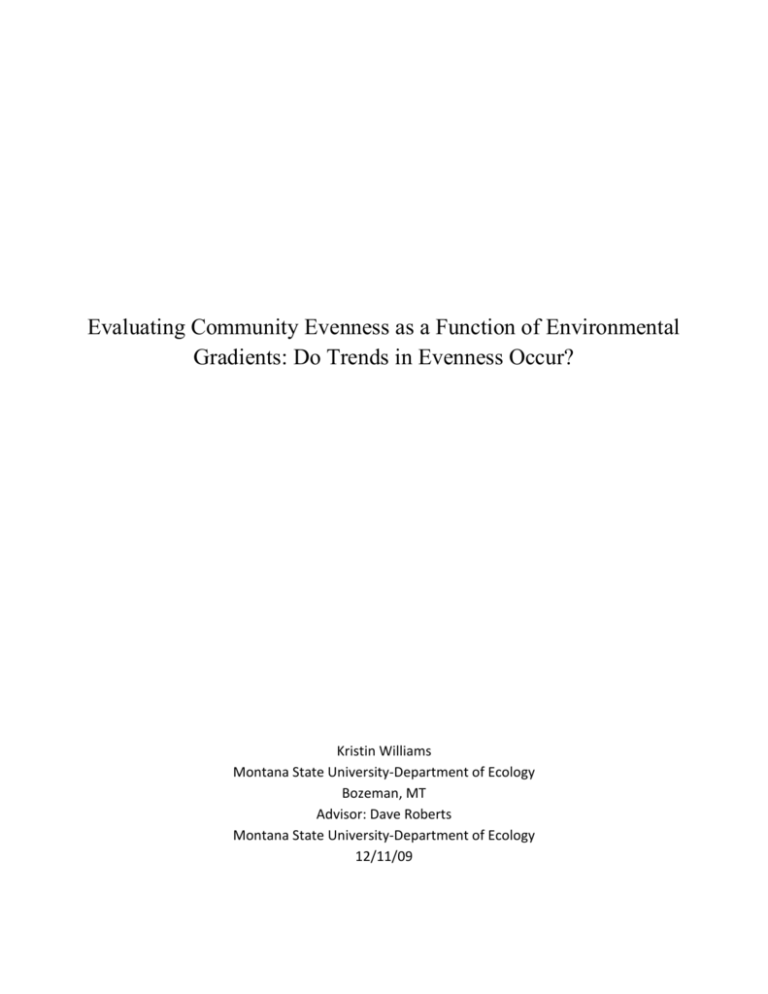
Evaluating Community Evenness as a Function of Environmental Gradients: Do Trends in Evenness Occur? Kristin Williams Montana State University-Department of Ecology Bozeman, MT Advisor: Dave Roberts Montana State University-Department of Ecology 12/11/09 Abstract Species evenness, the complement of species richness to diversity, refers to the way abundance is distributed among the species in a community. Many studies have sought to describe the evenness distribution within communities based on ecologically and statistically-based models (i.e. Geometric, Broken Stick, General Lognormal, etc…) of species abundance distribution. Very few studies, however, have looked at the distribution of evenness, as a community structure statistic, across environmental gradients. This is odd, as evenness is an index of community structure from which general patterns of community structure, regardless of species composition, might be inferred (Mason et. al., 2002). If communities with strong competitive interactions between species are more uneven than communities with weak competitive interactions between species (Cotgreave and Harvey, 1994), it would be reasonable to expect uneven communities to occur under similar, or at least identifiable, environmental conditions. The first step in this analysis will be to classify, using existing classifications where applicable and creating new classifications where necessary (>8,000ft.), the distinct vegetation community types observed in the Beartooth Mountain study area as detected by 210 sample plots collected during the 2008 and 2009 field seasons. An evenness statistic will be calculated for each plot using Hill’s ratio. Sample plot evenness values will then be averaged according to: 1) community type membership, 2) ecosystem type membership, and 3) lifeform category membership by community. ANOVA analysis will be used to determine whether differences between ecosystem type units, communities within each ecosystem type unit and lifeform categories between communities of the same ecosystem type unit are detectable. Regression analysis will be used to determine whether trends in community and lifeform category evenness distribution are correlated with measured and modeled environmental gradients. Table of contents 1) Abstract 2) Introduction 3) Literature Review a) Concept of Evenness b) Choosing an Appropriate Evenness Statistic 4) Approach 5) Measurement Methods a) Vegetation Community Plots i) Plot Size ii) Species Occurrence and Abundance Data iii) Soil Data iv) Environmental Site Data v) Material Used 6) Statistical Methods a) Estimating Total Sample Size b) Flowchart of Statistical Analyses to be Conducted to Answer Questions of Interest 7) Adequacy of Analysis 8) Timetable 9) Budget 10) Qualifications 11) Implications of Research Introduction Biological communities are often described in terms of species diversity, which is generally understood to be the product of two community components: richness and evenness (Drobner et. al., 1998; Whittaker, 1965; Tilman, 1996; Stirling and Wilsey, 2001). Species richness refers to the number of different species in a community large enough to include at least one rare species (Whittaker,1965). Species evenness refers to the way abundance is distributed among individual species in a community (Whittaker, 1975; Alatalo, 1981). Communities in which each species present is equally abundant have high evenness and communities where species differ widely in abundance have low evenness (Smith and Wilson, 1996). Species evenness tells the biological investigator something about community structure (Bastow, 1991). Intuitively, it seems that community structure should relate to underlying species competition and facilitation interactions, resource availability, environmental constraints and/or successional status of the community. Mason et. al. (2002) concluded that if there are forces (operating via mechanisms such as competition or evolution) that restrict the ways in which species assemble in communities, there will be patterns of community structure. Most studies to date have focused on patterns within communities and created models to explain scenarios under which such structures would be observed given a set of ecological or statistical assumptions. Very few studies, however, have asked whether observed patterns of vegetation community evenness are associated with large-scale environmental gradients and, if so, in what ways might these patterns be characterized? My proposed question of interest is: How is the community structure statistic of evenness distributed across modeled and measured environmental gradients of the Beartooth Mountain study area in south-central Montana? I plan on investigating this question from several angles. After calculating an evenness statistic for each sample plot, I will divide the plots into community type, lifeform type by community and ecosystem type groups and calculate an average evenness value for each membership scenario. I will use ANOVA analysis to determine whether or not the averaged evenness values are more different between scenarios than would be expected if evenness were randomly distributed across scenarios. I will then use regression analysis to look at the relationships between individual sample evenness statistics and averaged group evenness statistics across environmental gradients. Discovering underlying relationships, if any exist, between environmental gradients and community evenness is a step toward developing studies that investigate measureable attributes of evenness as a changing community diversity component (Pielou, 1965). The Beartooth Mountain study area is located completely within the boundaries of the Custer National Forest. It is bordered to the south, southwest and west by the Gallatin National Forest and to the far southwest by Yellowstone National Park. The southern boundary of the study area is demarcated by the Wyoming state border. It is an ideal place from which to identify trends in community evenness distribution across environmental gradients. The study area is primarily comprised of the largest alpine plateau in the lower 48 states, but also contains mid-elevation, forested communities and low elevation grassland/shrubland communities. As such, a wide range of elevation, slope percent values, aspect values, major geologic units, daily average temperatures, total precipitation values and annual solar radiation units are represented in the study area. The alpine ecosystem type unit dominates the southern portion of the study area. The northeast margin is characterized by steep slopes that quickly descend from the top of the alpine plateau to the sprawling and significantly more temperate foothill ecosystem below. There is also a distinct moisture gradient present, ranging from generally wetter conditions in the northwest to generally drier conditions in the southeast. Geologically, the core of the Beartooth Mountains is dominated by Precambrian granitics and is flanked to the northeast by a series of Cambrian to Cretaceous sedimentary rocks. The Cretaceous volcanic rocks of the Slide Mountain Formation occupy the northwestern arm of the study area and the Lindley conglomerate member of the Paleocene Fort Union formation occurs in a small portion of the southeastern portion of the study area. Most recently, Pleistocene glaciers receded toward the northeastern boundary of the Beartooth Mountains leaving cirque basins, glacial troughs, glacial deposits, lateral moraines along major drainages and outwash till along the northeastern flank in their wake. Major topographic features include: high elevation alpine turf plateau, timber plateaus, glacial troughs and U-shaped valleys, glacial cirques, stream dissected mountain slopes, granitic glacial till deposits, outwash till deposits/glacio-fluvial fans and up thrust limestone blocks, hogbacks and sandstone-shale-limestone dipslope-scarp complexes. The sample plot data to be used for this analysis was collected during the 2008 and 2009 field seasons for the purposes of a United States Forest Service (USFS) and Natural Resource Conservation Service (NRCS) collaborative inventory/mapping project called a Terrestrial Ecological Unit Inventory (TEUI). TEUI’s are an attempt to produce large scale, consistent and integrated ecosystem inventory, community/habitat type classification and mapping management tools for all public lands nationwide. While sampling efforts for the project began in 2004, plots from the2004, 2006 and 2007 field seasons often had incomplete species lists and will not be used in this analysis. Literature Review Concept of Evenness: Studies of evenness within communities have generally attempted to fit dominance/diversity data to models, such as the Geometric Series, the Lognormal Distribution, the Broken Stick Model, the Balls and Boxes Model, and several others (Whittaker, 1965; Cohen, 1968). Resource-apportioning models generally apply over ecological and evolutionary time. In ecological-time models, species abundances are seen as the result of competition and other ecological interactions; in evolutionary-time models abundances are seen as innate properties of the species and a result of co-evolution (Hulbert, 1971). The broken stick, balls and boxes, lognormal and geometric models are all examples of resource-apportioning models.. The broken stick model assumes that some critical abundance limiting factor in the environment is fixed at quantity ‘s’ units, that n-1 points could be uniformly randomly distributed between zero and ‘s”, and that the critical factor is subsequently divided into ‘n’ intervals. The order statistics of interval size are the interval lengths rearranged in order of increasing size. The model predicts that the ranked average abundances of the species will be proportional to the expected values of the order statistics of interval size. The biological interpretation of this model has been to assume that species partition the available, fixed supply of a critical factor into mutually disjoint, exhaustive subsets (Cohen, 1968). Cohen (1968) also states that if the model is to have any usefulness, the critical factor must be some measurable dimension of species’ niches. The balls and boxes model likens the environment to a target of n boxes. Each box represents a “subniche.” The set of all boxes occupied by balls of a species at the end of the game is that species’ niche. The ‘n’ species distribute balls into the boxes until each species’ “niche” contains a number of subniches different from the number of subniches in the niche of each other species. The balls and boxes model predicts that the ranked average abundances of the species will be proportional to the ranked expected values of the numbers of balls thrown by each species. The simplified biological interpretation of this model is that the principle of competitive exclusion is satisfied by letting species niches overlap as long as there is at least one subniche they do not have in common. This model requires a weaker form of exclusion than the broken-stick model, but leads to the same predictions of ranked average abundances. Essentially, the Broken Stick model assumes that only one stick is being broken while the Balls and Boxes model assumes that there are many sticks being broken, but each species will get a larger portion of one broken stick and smaller or no portions of the others. Cohen (1968) found that the broken stick model, balls and boxes model and geometric series model all had the same results even though the assumptions for each are very different (Cohen, 1968). According to the Gause theory of competitive exclusion, no two species in a stable community will occupy the same niche and compete for the same environmental requirements in the same part of intra community space at the same time (Whittaker, 1965). If this is the case, the models above explain a fictitious environment. Whittaker (1965) defines competition as “the situation in which, (i.) environmental resources are limited in amount, (ii.) each species population increases to a maximum determined by the resources available to it, (iii) amounts available to a given species are affected or determined by the use of these resources by other species of the community, and (iv) species populations are consequently limited by the presence of other species, a limitation which is often mutual.” Additionally, each species will occupy the niche space to which it is best adapted as extensively and densely as competition and environmental limitations will allow and the fraction of environmental resources utilized along with the fraction of total community production realized by each species should be closely related to the fraction of niche space occupied (Whittaker, 1965). While it is very difficult to pinpoint the critical resource/resources or species’ interaction processes responsible for species niche distribution in a single community, evaluating the distribution of evenness across ecosystem types, community types, community lifeform categories and environmental gradients may serve to illustrate more general trends of niche distribution and/or resource utilization. It will be critical to search for trends between all group memberships and of all group memberships across environmental gradients because “there is no reason why species-diversity relations for different strata or fractions of the community, subject to different environmental factors and modes of population limitation, should parallel one another, and they often do not (Whittaker, 1965).” Choosing an Appropriate Evenness Statistic: Many indices have been proposed to calculate evenness. The most popular of which are: the reciprocal of Simpson’s Index, Shannon’s-Weiner diversity index (H’), Hill’s Ratio (N2/N1) and eveness (J’) Camargo’s E. Different indices measure different aspects of the partitioning of abundance between species in a community and particularly differ in their propensity to include or to exclude the relatively rare species (Hill, 1980). Simpson’s index, for example, is sensitive to the abundance of the more plentiful species in a sample (Whittaker,1965; Hill,1980). Whittaker (1965) said that the evenness statistic needs to be characterized both by the dominance concentration and species richness. Camargo (1995) objected to the use of Simpson’s and Shannon-Wiener’s diversity statistics because of their dubious ecological interpretation and sensitivity to the relative abundances of dominant species, particularly claiming that Simpson’s (1949) index “should be regarded as a deficient statistic of species uniformity rather than a statistic of species dominance [evenness] (1995).” Most people have forsaken J’ because it is mathematically positively correlated with species richness (Alatalo, 1980). Routledge’s (1983) provided three requirements of a sufficient evenness statistic: 1) it should be decreased by marginally reducing the abundance of the rarest species in the community, 2) it should also be decreased by the addition of a further exceedingly rare species to the community, and 3) it should depend continuously upon the proportional abundance of any species in the community. To date no evenness ratio meets all three requirements. Most commonly, the 1st and 2nd are met. Hill’s ratio satisfies the first two criteria and remains stable irrespective of species richness (Alatalo, 1980; Hill, 1973; Tallie, 1979). This is because Hill’s ratios are calculated using species directly as units, thus escaping the pitfalls of logarithms (Alatalo, 1980; Camargo, 1995). Additionally, the sampling bias of Hill’s Ratio is much smaller for Hill’s number N1 and N2 because they are not equally sensitive to the exclusion of the rarest species (Camargo,1995). This is important since species richness is often underestimated resulting in an overestimation of evenness. Hulbert (1971) stated that “differences in species richness pose no problem to statistical comparisons of species evenness so long as V indices are used.” Hill’s ratio is a V index (Hulbert, 1971). Based on the conclusions drawn from previous research pertaining to the applicability, appropriateness and behavior of various evenness indices, for the purposes of this analysis I will calculate evenness using Hill’s unmodified ratio. The unmodified Hill’s Ratio: (N2/N1) p1,p2, p3……pn : these denote the proportional abundances (% cover of each species to total % cover of the sample plot OR % cover of each species to total % cover of lifeform category) of n species N2= 1/Ʃpi² : this is the reciprocal of Simpson’s index and the probability of interspecific encounter divided by the probability of intraspecific encounter. N1= expH’, antilogarithmic Shannon’s entropy, where H’= -Ʃpi ln(pi) No=species richness Approach The goal of this project is to use the 2008 and 2009 Beartooth Mountain Study Area TEUI data to: 1) create a vegetation community type classification key for alpine communities (those >8,000ft.) of the study area, 2) assign communities below 8,000 ft. to appropriate existing vegetation community classifications and modify existing classifications where necessary to reflect locally specific variations, and 3) calculate sample plot evenness, averaged community evenness and averaged ecosystem type evenness in order to answer the questions of interest. The questions of interest are: 1.) Does the averaged community evenness vary by ecosystem type unit more than would be expected if evenness were distributed randomly across ecosystem type units? Ho1: Average evenness is the same for each of the three broad ecosystem-type units. Ha1: Average evenness is different for one or all of the three ecosystem types. 2.) Does the averaged community evenness vary by community type more than would be expected if evenness were distributed randomly across community types? Ho2: Average community evenness is the same for all community types. Ha2: Average community evenness of at least one community type is different. 3.) Are there differences in averaged lifeform category evenness distribution between community types of the same broad ecological type unit? Whittaker (1965) stated that “there is no reason why species-diversity relations for different strata or fractions of the community subject to different environmental factors and modes of population limitation, should parallel one another; and they often do not.” Ho3: Lifeform category evenness will remain constant between community types of the same broad ecological-type unit. Ha3: Lifeform category evenness will vary between community types of the same broad ecological-type units. 4.) Are observed differences in average evenness of ecosystem type unit and/or community type associated with one of the measured or modeled environmental variables? Ho4: Averaged community type evenness and/or averaged ecosystem type evenness are distributed randomly with respect to measured and modeled environmental variables. Ha4: Averaged community type evenness and/or averaged ecosystem type evenness are more significantly associated with one or more of the environmental variables than would be expected if averaged community and ecosystem evenness distribution were random in relation to all environmental variables. Data must be collected in an integrated manner and decisions rules pertaining to sample selection must be established prior to beginning sampling efforts. Vegetation, soils, landform, surficial geology, and bedrock geology will be fully described for every sample site used to establish an ecological type and document a map unit. At each sample site, the plot should be uniform in environment and vegetation, large enough to include the normal species composition of the stand and have homogenous vegetation throughout the sample plot. Obvious ecotones, or sites lacking environmental uniformity, will not be suitable for sampling. In addition to identifying a target GPS point for each sample plot, additional information including: target slope percent, target aspect value and target community type will be identified. If, upon arriving at the target GPS point, as identified by latitude, longitude and elevation, it is obvious to the botanist and soil technician that the community occurring at the target GPS point is an ecotone between two communities, is not representative of the dominant community type for the specified target slope percent and aspect value, then the field technicians may move the sample plot to the closest plot center that reflects the dominant community type vegetation for the target slope and aspect value. If no such representative community can be found, a community sample plot will not be collected. Plots will be identified using a stratified sampling plan, where the study area is initially divided into “ecological units.” Each ecological unit will represent a unique, large-scale, geologic type and topographic landform combination. All possible combinations are represented by a distinct ecological unit. Within these units, the plot centers for 405m.² circular plots (11.35m. radius) will be selected to reflect dominant vegetative community types. Dominant community types within each unit will be identified using aerial photos, satellite imagery and potential indicated by topographic maps. Plots will be distributed within each ecological unit to represent the diversity of slopes, elevations, aspects and dominant community types available for that ecological unit and were also distributed spatially across the study area for each ecological unit to represent the larger range of environmental gradients. Two hundred plus vegetation community plots will be collected during the 2008 and 2009 field seasons. These data will be used for this analysis. Information collected on each of these plots will include: a complete species list, ocular aboveground cover estimates for each plant species, elevation, slope and aspect. Major geologic units have already been mapped (Vaseth and Montagne, 1980) and modeled values of relative effective annual precipitation, total annual precipitation, average daily temperature and units of solar radiation loading (what units) will be obtained from NRCS models and used in this analysis. Averaged community type evenness will be calculated by averaging the sample evenness value of all samples in that community type. Averaged ecosystem type evenness will be calculated by averaging the sample evenness values of all samples in each ecosystem type. Average lifeform category evenness by community will be calculated by averaging the sample evenness values of each community type and ecosystem type by lifeform category. The three broad ecosystem type units represented in the study area are: low elevation shrubland/grassland communities, mid elevation forest communities and high elevation alpine turf communities. All community plots with tree cover >10% will be included in the mid-elevation, forested ecosystem type, grassland/shrubland communities below timberline will be grouped in the low elevation grassland/shrubland ecosystem unit and grassland/shrubland/turf communities above timberline will be grouped in the alpine ecosystem unit. Measurement Methods Vegetation data will be collected using ocular macroplots and variable-radius plots. As a rule of thumb, ocular macroplots need to be big enough that enlarging the plot would add no or very few species in order to accurately estimate community evenness. Variable-radius plots are used to determine density and basal area of live trees and snags on the plot. Soil pedon data will be collected according to NCSS standards and using codes and procedures in the NRCS publication Field Book for Describing and Sampling Soils (Shoeneberger et al., 2002) and sufficient for soil classification. Geologic information will be collected according to the standards in the Forest Service Manual 2881, surficial geology origin and kind using the terms and definitions listed in the FRIS Terra data dictionary and the depth to bedrock will be recorded where bedrock encountered. Geomorphic information is collected to the standards in A Geomorphic Classification System (Haskins et al. 1998). At a minimum, plot locations will be assigned a classification from the list of hierarchy geomorphology classes in Appendix E to describe the dominant, active landform-process relationship. Vegetative Community Plots: Plot Size Each sample plot will be a minimum of 405 m.², or a tenth of an acre. Hulbert (1971) states that “as with species richness, comparisons of species evenness are meaningful only when all collections are adjusted to a common size and that when other things are equal, larger collections will have more rare species and always a lower V and V’ value. Plots with greater than 10% tree cover will be considered “tree plots” and subjected to plot size adjustments in relation to slope percent. Once a plot center is established and it has been determined whether the community being described is a tree or non-tree dominated community, the margins of the plot are marked by running out a meter tape to the appropriate radius length and marking the perimeter with flags. The radius length for all non-tree community plots will be 11.35 m. (405 m.²). In communities with >10% tree cover, the initial macroplot radius length of 11.35 m. will be increased in length as slope percent increases. The conversion table is shown below (Macro Plot Radii in m. corrected for slope). For example, if the slope of a tree-plot is between 18 and 22%, the macroplot radius would be 11.46 m.. This adjustment geometrically calibrates tree abundance estimates to abundance estimates of forbs, grasses and shrubs. Tree plots will additionally contain a microplot, also centered at plot center, designed to estimate stand regeneration. Microplots will also be adjusted in relation to slope percent (Micro Plot Radii in m corrected for slope). Macro Plot Radii in m. corrected for slope (1/10 acre, ~405m²) r 11.35 11.40 11.46 11.52 11.58 11.64 11.67 11.73 11.79 11.85 11.91 11.94 12.01 slope % 0-9 10--17 18-22 23-26 27-30 31-33 34-36 37-39 40-42 43-44 45-47 48-49 50-51 r 12.07 12.13 12.16 12.22 12.28 12.31 12.37 12.43 12.49 12.52 12.58 12.65 12.68 slope % 52-53 54-55 56-57 58-59 60-61 62-63 64-65 66-67 68-69 70 71-72 73-74 75 r 12.74 12.80 12.83 12.89 12.95 12.98 13.04 13.07 13.13 13.19 13.22 13.28 13.32 slope % 76-77 78-79 80 81-82 83 84-85 86 87-88 89 90-91 92 93-94 95 Species Occurrence and Abundance Data A complete species occurrence list will be collected within the boundaries of the community macroplot. Abundance of each species will be measured using canopy cover estimates. Since plants show huge plasticity between individuals and it is often impossible to define an individual, measuring percent cover as an indicator of biomass production is a useful for plant diversity/dominance measurements (Bastow, 1991). Canopy cover will be defined as the percentage of ground covered by a vertical projection of the outermost perimeter of the natural spread of foliage of plants where small openings within the canopy are included in the cover estimate. Only species, individuals and layers occurring within the plot boundary will be recorded and their cover included in cover estimates. Cover for each species will be estimated as follows: • Use 0.1 as “trace” for items present but clearly less than 1 percent cover (1% = 1.1m. radius ). • Estimate to the nearest 1 percent between 1 and 10 percent cover. • Estimate to at least the nearest 5 percent between 10 and 30 percent cover. • Estimate to at least the nearest 10 percent for values exceeding 30 percent cover. After estimating total cover for each species, cover will be estimated by lifeform categories and subcategories using the same cover estimation scheme described above. Lifeform categories include: trees, shrubs, dwarf shrubs, forbs and graminoids. The tree lifeform category will be further divided into strata subcategories, including: total overstory, total regeneration, main canopy, supercanopy, subcanopy, saplings and low and high seedlings. Specific tree layer and lifeform category definitions are provided below. 1.) Tree Layers: Overstory (TO): The overstory layer includes all trees greater than or equal to 5 meters in height that make up the forest canopy. In dwarf tree stands, the overstory consists of trees that have attained at least half of their sites specific potential height growth and make up the forest canopy. Regeneration (TR): The regeneration layer includes all trees less than 5 meters in height. In dwarf tree stands the regeneration layer includes trees that have attained less than half of their site-specific potential height growth and are clearly overtopped by the overstory trees. The overstory will optionally be subdivided into the following sublayers, if they occur, to describe stand structure in more detail: Main canopy (TOMC): The dominant and co-dominant overstory trees that receive direct sunlight from above and make up the majority of the forest canopy. Supercanopy (TOSP): Scattered overstory trees that clearly rise above the main canopy. Subcanopy (TOSB): Overstory trees that are clearly overtopped by and separate from the main canopy, but are larger and taller than the regeneration layer. The regeneration layer will be subdivided into the following sublayers: Saplings (TRSA): Regenerating trees greater than 1.4 meters (4.5 feet) in height, or regenerating dwarf trees greater than 1 meter in height. High Seedlings (TRhSE): Regenerating trees between .5 meter and 1.4 meters in height. Low Seedlings(TRlSE): Regenerating trees less than .5 meters in height. 2.) Lifeform categories: Total vegetation cover. Record the percentage of the ground covered by a vertical projection of the outermost perimeter of the natural spread of foliage of all vascular plants within the sample unit (plot or transect). Tree cover. Record the total cover of trees, defined as woody plants that generally have a single main stem, have more or less definite crowns, and are usually equal to or greater than 5 meters in height at maturity. Shrub cover. Record the total cover of shrubs, defined as woody plants that generally have several erect, spreading, or prostrate stems which give it a bushy appearance, and are usually less than 5 meters in height at maturity. Dwarf shrub cover. Record the total cover of dwarf shrubs, defined as caespitose, suffrutescent, matted, or cushion-forming shrubs which are typically less than 50 cm tall at maturity due to genetic and/or environmental constraints . Herb cover. Record the total cover of herbs, defined as vascular plants without significant woody tissue above the ground, with perennating buds borne at or below the ground surface. Includes: forbs, graminoids, ferns, and fern allies. Herb cover must be equal to or less than the sum of graminoid cover and forb cover. Graminoid Cover. Record the total cover of graminoids, defined as flowering herbs with relatively long narrow leaves and inconspicuous flowers with parts reduced to bracts. Include grasses, sedges, rushes, and arrowgrasses. Forb Cover: Record the total cover of forbs, defined as spore-bearing herbs or flowering herbs with relatively broad leaves and/or showy flowers). Include ferns or fern allies. In addition to estimating the total cover of each species and lifeform category/subcategory, predominant plant heights for each species and category/subcategory will be recorded. Predominant species height is the prevailing upper height for each species to the nearest tenth of a meter. Tree height for the overstory and regeneration layers will be recorded to the nearest meter and tenth of a meter, respectively. Height of overstory layers will be determined by selecting a representative tree in each and measuring its height using a clinometer and measuring tape. The representative tree for the overstory layer must be in the main canopy. Predominant plant height will also be recorded for each optional sublayer. The possibility of overlap between sublayers requires that overstory and regeneration cover for each tree species be estimated or measured directly, not calculated by summing the sublayer cover values. First, canopy cover will be estimated by sublayer and then the estimate of the overlap (if any) between sublayers to will be subtracted to derive the canopy cover of overstory and regeneration layers. Soil Data: A soil pit will be dug near the center of each vegetative community plot in an area that appears to be representative of the soils supporting vegetative community development. All soil pits will be dug to a depth of 1 m. where possible. If lithic contact is made prior to reaching a depth of 1m., the type of and depth to contact will be recorded. A high percentage of cobbles and stones in lower layers will not be sufficient reason to stop digging prior to reaching 1 m. depth. However, in order to be efficient in our data collection efforts, a maximum time limit of two and a half hours will be set for the digging of each soil pit. If at the end of two and a half hours, the soil technician has not been able to dig to 1 m., then the depth reached will be recorded along with a description, both written and sketched, of the conditions making it impossible to reach a meter within the allotted time. The overriding goal is to reach 1 m. or lithic contact in each soil pit. Once the pit is dug, the soil horizon layers will be identified and demarcated using nails. Each horizon will be measured from the top to the bottom and a height will be recorded. Each horizon will also be textured, colored (either wet or dry but must be indicated) and pHed individually. Textures must include texture modifiers, such as: percent gravel, cobble, stone, boulder, etc. Additionally, root pore percentage, clay film percentage, calcium carbonate accumulation and redoximorphic features will be observed and their abundance estimated for each horizon. Where redoximorphic and/or calcium carbonate features are observed, the depth to the beginning and end of that feature will be recorded along with color classes specific to the feature. Once the horizons have been textured, colored, pHed and otherwise described, the soil will be classified using the NRCS soil classification key and the classification will be recorded. In order to classify the soil, the soil moisture and temperature regimes must also be determined. A picture of each soil pit, including horizon demarcation nails and a hanging 1 m. long nylon strap divided into 1/10 m., will be taken and the picture number recorded. The hanging nylon strap will serve as proof that the target depth of 1 m. was achieved. It is important to note that all of the above should be done in the field at the soil pit. Before filling in the pit, the soil technician will collect a soil sample from each horizon. The sample should be representative of the horizon and should include a sample of any gravel or cobble common to the horizon. If calcium carbonate accumulations or redoximorphic features were encountered, these features should also be included in the sample. A sample of the organic horizon will also be collected. These soil samples will be taken back to the lab and organized into soil boxes. Each soil box will be representative of the sample plot and each compartment within the box will be representative of a described horizon. The horizons will be organized in the box from left to right in relation to the depth of the horizon in the soil pit, where the deepest horizon goes in the leftmost compartment and the organic layer in the rightmost compartment. A total of ten representative samples will be sent to a lab for analysis. The additional lab analysis will serve as a quality control measure aimed at confirming the textures, colors, pHs and soil classifications determined by the soil technician in the field. Environmental Site Data: In addition to vegetative community data and soil data, site description and documentation variables will be recorded. They include: GPS location, Potential Natural Vegetation classification, plot photo number and description, elevation (as recorded by the GPS), slope (%), aspect (degrees - field declination = 0), horizontal slope shape and vertical slope shape (diagramed below), slope convexity, slope position and the slope position modifier. Slope complexity will be described as either simple (S), indicating a slope that is linear, convex or concave in shape or complex (C), indicating broken, undulating, or patterned slope shape. Slope position will be described by one of five codes: summit (SU), shoulder (SH), backslope (BS), footslope (FS), toeslope (TS). Each slope position will be modified by one of the following descriptors: lower (LR), mid (MD) or upper (UP), where the position modifier indicates whether the plot position is in the lower, middle or upper elevations, respectively, of the slope position recorded. Materials Used: GPS units will be used to record coordinates. A stake will be used to mark plot center and to secure the meter tape while the radius is flagged. Plots will be photographed from the perimeter toward the staked center using a digital camera. Slope percent will be measured using a clinometers and will be measured from the uppermost perimeter slope to the lowermost perimeter slope. Aspect will be recorded using a compass with the declination set to 0 for consistency purposes. Tree height will be measured using a clinometers and meter tape. Plants of Wyoming (Dorn, 1977), Plants of Montana (Dorn, 1984) and Plants of the Pacific Northwest (Hitchcock and Cronquist, 1973). Plants that are unknown will be collected, recorded and pressed in a plant press. Soil pedon pits will be dug using a steel, Montana Sharpshooter © shovel. A soil sifter will be used to prepare soil for texturing, a pH indicator kit will be used to pH soils for soil classification, and 5M hydrochloric acid will be used to test the effervescence of soil. The rest of observation will be made using ocular estimation techniques described above. Several vegetation community classifications pertinent to the study area have been completed. The Shoshone National Forest, neighbor to the Beartooth study area to the south and southeast and similar to the Beartooth study area in terms of ecosystem type units and vegetation community types likely to present, recently completed a classification type key. The sample stratification for the Shoshone community classification was also organized according to TEUI vegetation and NRCS soil sampling protocol and will serve as the most appropriate pilot study for use in estimating sample size requirements. Other useful community classifications include: Grassland and Shrubland Habitat Types of Western Montana (Mueggler and Stewart, 1980), Plant Community Classification for the Alpine Vegetation of the Beaverhead National Forest, Montana (Cooper et al, 1997), Habitat Types of Eastern Idaho and Western Wyoming (Steel et. al., 1963), Habitat Types of Montana (Phister et. al., 1977), The Alpine Vegetation of the Beartooth Plateau in Relation to Cryopedogenic Processes and Patterns (Johnson and Billings, 1962). Other alpine classifications describing alpine vegetation of the northern rocky mountains include: Glacier National Park (Bamberg and Major, 1968), the Big Snowy Mountains and Fling Creek Mountains (Bamberg and Major, 1968) and Field Guide to the Willows of EastCentral Idaho (Stephen Brunsfeld, 1985). Statistical Methods The first analysis to be conducted is the identification and description of alpine (>8,000ft.) vegetation community types of the Beartooth Mountain study area. The community classification conducted on the Shoshone National Forest, neighbor to the Beartooth study area to the south and southeast and similar to the Beartooth study area in terms of ecosystem type units and vegetation community types likely to present, will serve as a good model for the analysis to be conducted here. The sample stratification for community classification was conducted using TEUI vegetation and NRCS sampling protocol, as this project proposes to do. The same statistics that will be calculated for the evenness analysis of the Beartooth Mountain communities and ecosystem types will first be calculated using data from the Shoshone National Forest TEUI database. By attaining an estimate of variance for all statistics from a dataset expected to be reasonably similar in community and ecosystem type and structure, an estimate of minimal necessary plots may be made. The first three questions of interest will be answered using a one-way ANOVA. ANOVA tests assume that sample cases are independent, samples come from a normally distributed population and samples have equal variance. If these assumptions cannot be met using our data set, it may be necessary to use a Kruskal-Wallis ranked sum test because the assumptions of normal distribution and equal variance are relaxed. The primary statistical test to be used to model sample, community and ecosystem evenness distribution across measured and modeled environmental gradients will be multiple linear regressions. Estimating Necessary Total Sample Size and Sample Community Replication Size: Calculate Shoshone National Forest community variance using a distance/dissimilarity matrix, such as Bray-Curtis. Obtain estimates of within and among community species occurrence and abundance variance. Also calculate the mean and variance of evenness distribution within and among communities and ecosystem type units. Calculate the minimal number of plots needed to accurately define dominant community types from Shoshone within and among community occurrence and abundance variance. Calculate the minimal number of plots needed to recognize variation in sample, community and ecosystem type units. Flowchart of statistical analyses to be conducted to answer questions of interest: Classify Community Types Divide Plots into Ecosystem Units ANOVA High Elevation Alpine Turf: Calculate Average Evenness Community Type “1”: Calculate Average Community Evenness ANOVA ANOVA Community Type “2”: Calculate Average Community Evenness HIGH ELEVATION ALPINE Mid Elevation, Forested: Calculate Average Evenness Community Type “3”: Calculate Average Community Evenness Community Type “4”: Calculate Average Community Evenness MID-ELEVATION FORESTED Low Elevation, Grassland/ Shrubland: Calculate Average Evenness Community Type “5”: Calculate Average Community Evenness ANOVA Community Type “n”: Calculate Average Community Evenness LOW ELEVATION GRASSLAND/SHRUBLAND 1.) Compare community average evenness within ecosystem types using ANOVA analysis to see if there are statistically significant differences in evenness between communities that may be drastically within ecosystem types that may be drastically affecting the differences that may or may not be observed between ecosystem type average evenness. 2.) Model community average evenness of all ecosystem types across selected environmental variables using multiple linear regression. 3.) Calculate average lifeform evenness for each community type and repeat steps 1 and 2 above, substituting “average lifeform evenness by community” for “community average evenness” for all tests. An example of average lifeform evenness by community would be the average evenness of each lifeform category (i.e. tree species, shrub species, grass species and forb species) in Pinus flexilis/Leucopoa kingii vegetation community types. Adequacy of Design The Shoshone National Forest vegetation community classification and sampling stratification was used as the pilot study for designing the sample stratification for the Beartooth Mountain vegetation community classification project. The number of samples per ecological unit is proportional to the percent of the study area defined as that ecological unit. The sample variance of each community type on the Shoshone National Forest will be calculated to estimate the number of plots needed to accurately identify dominant community types in the Beartooth Mountain study area. If enough plots are collected to confidently identify community types, then an appropriate level of replication should also be met for the evenness analysis. As the alpine ecosystem unit comprises a larger area of the Beartooth Mountain study area than the mid-elevation forested ecosystem or grassland/shrubland ecosystem, there will necessarily be higher replication in this ecosystem type. However, community level replication should be approximately evenly distributed across community types based on the sample stratification. To confirm that enough plots have been collected at all membership levels, the variance from the Shoshone pilot study will be calculated for all membership levels and minimal sample sizes will be determined for each. Timetable January February March April May June July August September October November December 2008 Preliminary planning phases. Delineation of ecological units. Stratification of Study Area and Creation of Sample Plan. Begin Field Work Field Work Field Work Plant Identification Plant Identification Plant Identification Done with Plant Identification 2009 Data Entry Data Entry Plan 2009 field season by checking current plot completion with overall goals. Begin Field Work Field Work Field Work Preliminary Data Analysis Preliminary Data Analysis Plant Identification Plant Identification 2010 Done with Plant Identification Data Entry Data Entry Community Classification Evenness Analysis Write Thesis Project Write Thesis Project Finish Thesis Project Budget Amount Salaries $1,500 (stipend) $1,500 (help with plant I.D.) Benefits $250 Equipment Equipment provided by TEUI project: backpacks, compasses, handlenses, tatums, clinometers, dbh tape, meter tape, GPS units, water filters, cameras and necessary software Travel $800 (pool vehicle) $400 (personal vehicle) Supplies and $300 (paper) Services $150 (write in the rain paper) $100 (pencils, erasers, pens, markers, etc..) $150 (copies of data sheets) Indirect + 18% for MSU overhead for offices and Costs/Overhead computers Total Number of Months 25 1 3 Total $37,500 $1,500 $750 5 1 FREE $4,000 $400 $700 $1450 $46,303 Qualifications Prior to beginning a graduate program studying vegetation ecology at Montana State University, I accumulated 9 seasons of field and office experience working as a vegetation ecologist/botanist for various agencies, including: the Forest Service, Idaho Fish and Game and University of Idaho Department of Agriculture. These positions taught me the importance of complete and consistent data collection, organization and analysis. I have worked as a crew leader and a crew member and feel confident that I can organize field efforts, maintain a budget and quality control data collection, database entry and data analysis efforts. As a graduate student, I have taken several upper division statistics and modeling courses that will enable me to perform the statistical analysis outlined in this report. Implications of Research In the past, the statistic of evenness has been primarily used to describe the distribution of species abundance within a given community. Researchers have looked for trends between evenness, richness and production in an attempt to model the underlying relationships between realized niche space and resource availability/species interactions. While it has remained nearly impossible to pinpoint the critical resource/resources or species’ interaction processes responsible for species niche distribution in a single community, the evaluation of evenness distribution across ecosystem types, community types, community lifeform categories and environmental gradients may serve to illustrate more general trends of niche distribution and/or resource utilization. If community evenness is consistently lower at certain ranges of given environmental gradients or in an ecosystem or community type, two conclusions are possible: 1) the resources available are fairly homogenous and/or 2) one species has effectively competitively excluded other species even if resources are somewhat heterogeneous. Similarly, if community evenness is consistently higher along sections of particular environmental gradients or in an ecosystem or community type, it is likely that: 1) the resources are fairly homogenous, and/or 2) evolution has produced a larger number of competing species, among which no one has so great a competitive advantage over all others (Whittaker, 1985). The investigation into evenness distribution between lifeform categories of different communities will further tease apart the dynamics of niche distribution and possibly provide some insight as to the relative importance of resource availability and/or competition to securing niche space in different communities. It is my hope that this project will result in valuable ecological conclusions that will expand the frame of current community ecology research and possibly provide baseline analysis that will prompt future researchers to further clarify the usefulness of evenness as a community structure statistic. Valery et. al. (2009) stated that “changes in evenness deserve increased attention because evenness usually changes more rapidly in response to human activities than does species richness and because evenness changes have important consequences for ecosystems long before a species is threatened by extinction.” If this is true, it is important to understand what changes in evenness may result in species extinction and which changes in evenness could be characterized as repeated results of succession. In order to understand these dynamics, it is necessary to begin to understand the dynamics that drive niche realization. References: Abrams (1995) Monotonic and Unimodal diversity-Productivity Gradients: What Does Competition Theory Predict? Alatalo, Rauno V. 1981. Problems in the measurement of evenness in ecology. Oikos 37: 199-204. Bastow, Wilson J. 1991. Methods for fitting dominance/diversity curves. Journal of Vegetation Science 2:35-40. Bliss, L.C. A Comparison of Plant Development in Microenvironments of Arctic and Alpine Tundras. Bulmer, M.G. 1974. On Fitting The Poisson Lognormal distribution To Species-Abundance Data. Biometrics 30: 101-110. Camargo, Julio A. 1995. On measuring species evenness and other associated parameters of community structure. Oikos 74(3):538-542 Cohen, Joel E. 1968. Alternate Derivations of a Species-Abundance Relationship. The American Naturalist 102(924): 165-172 Cooper, Stephen V., Lesica, Peter, Page-Dumroese, Deborah. 1997. Plant Community classification for the Alpine Vegetation of the Beaverhead National Forest, Montana. Intermountain Research Station, United States Department of Agriculture. Cotgreave, Peter and Harvey, Paul H. 1994. Evenness of Abundance in Bird Communities. Journal of Animal Ecology. 63:365-374. Dorn, R.D. 1992. Vascular plants of Wyoming. 2nd ed. Cheyenne, Wyoming: Mountain West Publishing: 340 p. Drobner, U., Bibby, J., Smith B., and Wilson, J.B.. 1998. The relation between community biomass and evenness: what does community theory predict, and can these predictions be tested? Oikos 82:295-302. Haskins et al., 1998. A Geomorphic Classification System. Hitchcock, CL and Cronquist, Arthur. 1973. Flora of the Pacific northwest. Seattle: London, Washington Press: 730 p. Hulbert, Stuart H. 1971. The nonconcept of species diversity: a critique and alternative parameters. Ecology. 52: 577-585. Mason, Norman W.H.; MacGillivray, Kit; Steel, John B.; & Bastow, Wilson, J. 2002. Do plant modules describe community structure better than biomass? A comparison of three abundance measures. Journal of Vegetation Science. 13: 185-190. Morin, Peter J. 1999. Community Ecology. Blackwell Publishing. 424p. Mueggler, WF and Stewart, WL. 1980. Grassland and shrubland habitat types of western Montana. Forest Service, General Technical Report. Intermountain Forest and Range Experiment Station: 154 p. Pielou, E.C. 1965. The Concept of Randomness in the Patterns of Mosaics. Biometrics. Routledge, R.D. 1983. Evenness indices: are any admissible? Oikos. 40:149-151. Shoeneberger, P.J., Wysocki D.A., Benham E.C., and Broderson, W.D. 2002. Field Book for Describing and Describing and Sampling Soils. National Soil Survey Center. Natural Resources Conservation Service. U.S. Department of Agriculture. Lincoln, Nebraska. Smith, Benjamin and Wilson, Bastow J. 1996. A Consumers Guide to Evenness Indices. Oikos, 76: 70-82. Stirling, Gray and Wilsey, Brian. 2001. Empirical Relationships between Species Richness, Evenness, and Proportional Diversity. The American Naturalist 138(3):286-299. Taillie, C. 1979. Species equitability: a comparative approach. –In: Grassle, J.F., Patil, G.P., Smith, W.K. and Taillie, C. (ed.). Ecological diversity in theory and practice. Int. Coop. Publ. House, Fairland, Maryland, p:51-62. Tilman, David. 1996. Biodiversity: Population Versus Ecosystem Stability. Ecology 77(2):350-363. Wells, Aaron F. 2008. Custer National Forest National Cooperative Soil Survey and Terrestrial Ecological Unit Inventory: Pre-Mapping, Preliminary Data Analysis, and Study Design Development. 239p. Valery, Loic; Fritz, Herve; Lefeuvre, Jean Claude; Simberloff, Daniel. 2009. Ecosystem-level consequences of invasions by native species as a way to investigate relationships between evenness and ecosystem function. Biological Invasions. 11:609-617. Vaseth, Roger and Montagne, Clifford. 1980. Geologic parent materials of Montana soils. Montana Agricultural Experiment Station, Montana State University. Whittaker, R.H. 1965. Dominance and Diversity in Land Plant Communities. Science 147:250-260. Whittaker, Robert H. 1975. Communities and Ecosystems 2nd Edition. MacMillan Publishing Co., New York. 385p. Winthers, E., Fallon, D., Haglund, J., DeMeo, T., Nowacki, G., Tart, D., Ferwerda, M., Robertson, G., Gallegos, A., Rorick, A., Cleland, D.T., Robbie, W. 2005. Terrestrial Ecological Unit Inventory technical guide. Washington, DC: U.S. Department of Agriculture, Forest Service, Washington Office, Ecosystem Management Coordination Staff. 245p.

